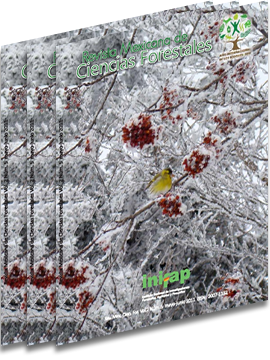CLIMATIC CHANGE ANd THE SYMBIOTIC STATE OF THE FOrEST TrEES
DOI:
https://doi.org/10.29298/rmcf.v2i5.580Keywords:
Climatic change, carbon sequestration, deforestation, greenhouse effect, ectomhicorrizae, micorrhizal fungiAbstract
The unanimous world agreement to reduce the greenhouse effect gas emissions to the atmosphere leads to consider the forms to contribute to the above mentioned labor with scientific arguments. Mexico’s Special Program for Climatic Change points out that 30% could succeed with the prevention of deforestation and woodland degradation and the recovery of forest areas. different terrestrial ecosystems have the ability to sequestrate carbon through plants and soil. The microbial biomass in the rhizosphere is up to 10 times higher than that of soil; these microorganisms transform the organic matter into humus, which is the most stable C. root biomass is higher with the presence of symbiotic microorganisms (ectomycorrhizal, arbuscural-mycorrhyzal, nitrogen-fixing); root symbiotic fungi are a main factor in maintaining the biodiversity and the ecosystem. High CO2 and atmospheric O3, affect symbiosis of trees as well as the altered nitrogen cycle (excess), temperature and modified precipitation, invasive species and the phytophatogens presence. The factors that participate in global change interact and have an impact on the mycorrhiza, direct and indirectly. They have an effect upon edaphic biota, as they impact the composition of the mycorryzal fungi community, on the stimulating bacteria of mycorrhization, on the plants that act as reservoir for symbionts, the invasion of non-mycorryzal plants, etc. Mycorrhiza are crucial in the soil - plant interphase, and by their influence in plant physiology and their communities, they must be included in the ecological studies about climate change.
Downloads
Downloads
Published
How to Cite
Issue
Section
License
The authors who publish in Revista Mexicana de Ciencias Forestales accept the following conditions:
In accordance with copyright laws, Revista Mexicana de Ciencias Forestales recognizes and respects the authors’ moral right and ownership of property rights which will be transferred to the journal for dissemination in open access.
All the texts published by Revista Mexicana de Ciencias Forestales –with no exception– are distributed under a Creative Commons License Attribution-NonCommercial 4.0 International (CC BY-NC 4.0), which allows third parties to use the publication as long as the work’s authorship and its first publication in this journal are mentioned
The author(s) can enter into independent and additional contractual agreements for the nonexclusive distribution of the version of the article published in Revista Mexicana de Ciencias Forestales (for example, include it into an institutional repository or publish it in a book) as long as it is clearly and explicitly indicated that the work was published for the first time in Revista Mexicana de Ciencias Forestales.
For all the above, the authors shall send the form of Letter-transfer of Property Rights for the first publication duly filled in and signed by the author(s). This form must be sent as a PDF file to: ciencia.forestal2@inifap.gob.mx
This work is licensed under a Creative Commons Attribution-Noncommercial 4.0 International license.






